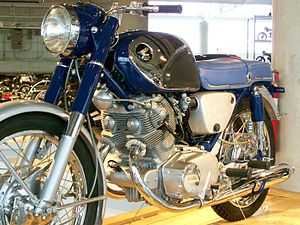Honda CB77
 | |
| Manufacturer | Honda |
|---|---|
| Also called | Super Hawk, Honda 305 |
| Production | 1961–1968[1] |
| Successor | CB350 |
| Engine |
305 cc (18.6 cu in) OHC parallel twin with two carburetors kick and electric start |
| Top speed | Near 100 mph (160 km/h) (claimed)[2] |
| Power | 28 hp (21 kW)[3] |
| Related | C77, CL77. Honda Dream CB250 |
The Honda CB77, or Super Hawk, was a 305 cc (18.6 cu in) vertical twin motorcycle produced from 1961 until 1967. It is remembered today as Honda's first sportbike. It is a landmark model in Honda's advances in Western motorcycle markets of the 1960s,[4] for its speed and power as well as its reliability, and is regarded as one of the bikes that set the paradigm for modern motorcycles.
Characteristics
The CB77 had, at only 305cc, a relatively big engine in comparison to most other Japanese bikes of the period, although it had performance to rival much larger motorcycles from other countries.[citation needed] It quickly built a reputation for reliability, and was equipped with luxuries such as an electric starter.[3]
The CB77 was built on the experience Honda had gained in Grand Prix racing, and differed greatly from previous models. It had a steel-tube frame instead of the pressed frames of earlier Hondas,[5] and a telescopic front fork.[1] The parallel twin engine (the biggest then available in a Honda) was an integral element of the bike's structure, providing stiffness in a frame that had no downtube, and was capable of 9,000 rpm. It could propel the bike at over 100 mph; as fast as British parallel twins with higher displacements, and with great reliability. It is now regarded as 'the first modern Japanese motorcycle...that established the motorcycle paradigm that we still operate under now, more than forty years later.'[5]
Related bikes
Honda also produced a lower-powered 247 cc (15.1 cu in) version called the CB72 Hawk, which otherwise had the same specifications. In 1962, Honda introduced an off-road bike, the CL72 250 Scrambler, with the same engine as the Hawk but with a different, full-cradle frame with a skid plate and other adjustments for off-road use. In 1965, the CL77 305 Scrambler appeared, with the (bigger) engine of the Super Hawk but otherwise similar to the CL72.[5]
Zen and the Art of Motorcycle Maintenance
Robert M. Pirsig rode a CB77 Super Hawk on the trip he made with his son and their friends in 1968 on a two month round trip from their home in St. Paul, Minnesota to Petaluma, California, which became the basis for the novel Zen and the Art of Motorcycle Maintenance: An Inquiry into Values.[6][3] The novel never mentions the make or model of Pirsig's motorcycle,[7] but Pirsig was, as of 2007, still the owner of his Super Hawk.[8]
References
| Wikimedia Commons has media related to Honda CB77. |
- ↑ 1.0 1.1 Mitchel, Doug (2005). Honda Motorcycles: Everything You Need to Know About Every Honda Motorcycle Ever Built. Krause. pp. 18–19. ISBN 9780873499668. Retrieved 5 December 2012.
- ↑ "Milestone model: 1961 CB77". Honda. Archived from the original on 2008-01-20. Retrieved 2008-01-12.
- ↑ 3.0 3.1 3.2 Gingerelli, Dain; Everitt, Charles; Michels, James Manning (2011), 365 Motorcycles You Must Ride, MBI Publishing Company, p. 126, ISBN 0-7603-3474-9, retrieved 2011-04-06
- ↑ Schilling, Phil. "The hawk above, the crud below." Cycle World Apr. 1999: 72+. General OneFile. Web. 6 Apr. 2011.
- ↑ 5.0 5.1 5.2 Frank, Aaron (2003-05-01). Honda Motorcycles. MotorBooks International. p. 59. ISBN 9780760310779. Retrieved 5 December 2012.
- ↑ Mehren, Elizabeth (11 October 1991), "Zen and Now : Robert M. Pirsig rode a 'Motorcycle' to fame. He's back with a bleaker tale of troubled times", Los Angeles Times: 1, retrieved 2011-04-06
- ↑ Richardson, Mark (2008), Zen and now: on the trail of Robert Pirsig and Zen and the art of motorcycle maintenance, Random House, p. 5, ISBN 0-307-26970-1, retrieved 2011-04-06
- ↑ Wasef, Basem; Leno, Jay (2007), Legendary Motorcycles: The Stories and Bikes Made Famous by Elvis, Peter Fonda, Kenny Roberts and Other Motorcycling Greats, MotorBooks International, p. 165, ISBN 0-7603-3070-0, retrieved 2011-04-06
| ||||||||||||||||||||||||||||||||||||||||||||||||||||||||||||